Air plants, a.k.a. Tillandsia, are becoming increasingly popular due to their unique appearance and ease of care. Unlike traditional plants that require soil, air plants can grow on various surfaces, making them an excellent choice for decorating homes and offices.
But, do you know how long do air plants live?
While they may seem low-maintenance, it’s crucial to understand the lifespan of these plants and the factors that affect them. Proper care can help extend their lifespan and ensure they thrive in any environment.
In this article, we’ll go through all things relating to the lifespan of air plants in detail, including the different factors that affect their longevity.
By the end of this article, you should have a good grasp of air plant lifespan and how to keep them happy and healthy for years to come.
Sound good? Let’s go!
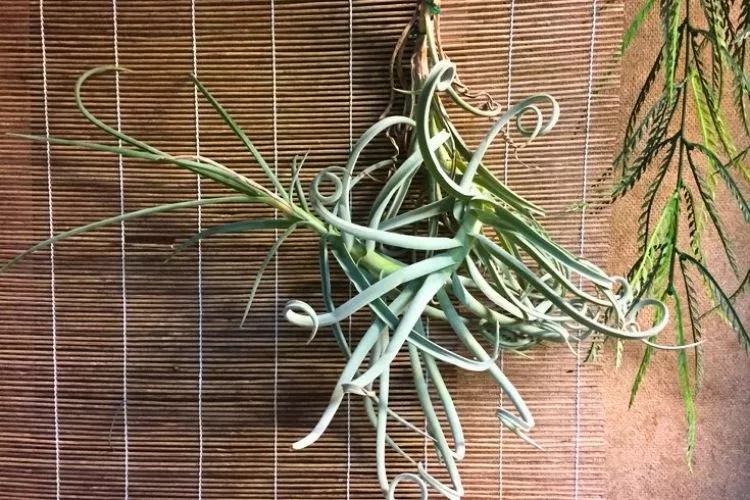
Table of Contents
Factors that Affect the Lifespan of Air Plants
In this section, we’ll explore the various factors that affect the lifespan of air plants. First and foremost, the care and maintenance of these types of plants are essential for their longevity.
Therefore, understanding the following factors will help ensure your plants live long and healthy lives under your care.
Type of the Plant
The type of air plant is one of the most defining factors that can affect an air plant’s lifespan. Different species have varying needs. These include their water intake, reliance on light, and nutrient requirements. It’s important to research the specific needs of your air plant before planting it to provide it with the best care possible.
Propagation Method
Air plants can be propagated through seed, division, or even offsets. Division is the most common and easiest method of propagation. This practice involves separating the offsets from the parent plant.
Here’s a simple step-by-step guide on how to propagate air plants through division:
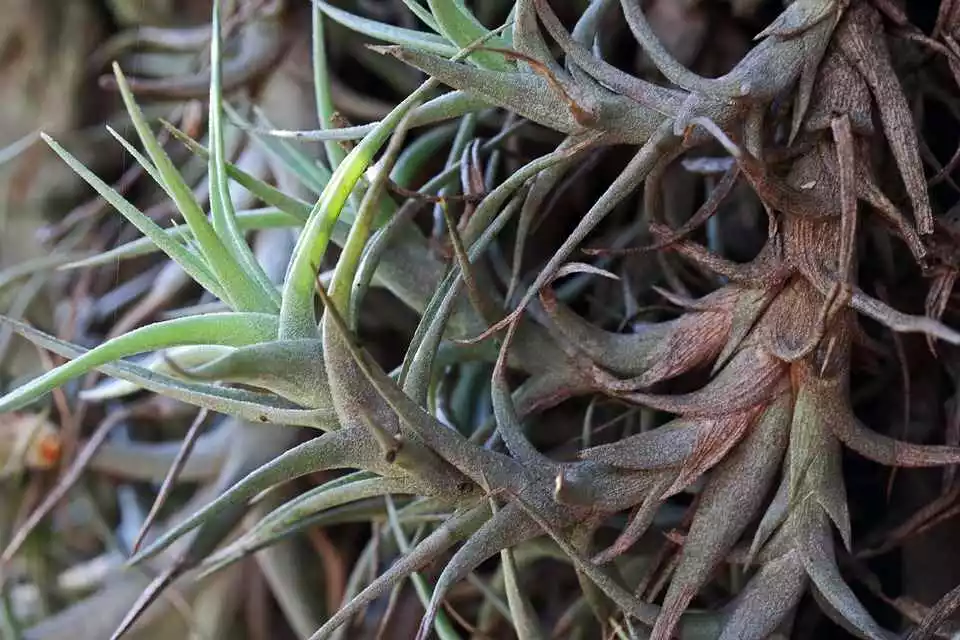
- First, identify a healthy air plant that has already produced a set of offsets.
- Gently remove these offsets from the parent plant using your hands or a sterile tool such as gardening shears or scissors.
- Rinse the offsets under running water and let them dry for a few hours.
- Place the offsets in a new container filled with a suitable growing medium. (sand or pebbles, however, they are air plants, so a medium isn’t necessary)
- Water the offsets lightly and place them in a location with bright, indirect light. The best method is by dunking or misting. However, misting is a lot easier once set in place.
- Wait and enjoy!
Environmental factors
Air plants thrive in various environmental conditions, but some factors can affect their lifespan. Temperature, humidity, light, and air circulation are crucial for their growth and health.
So, paying attention to them and adjusting where necessary is advised. Let’s have a closer look at these factors:
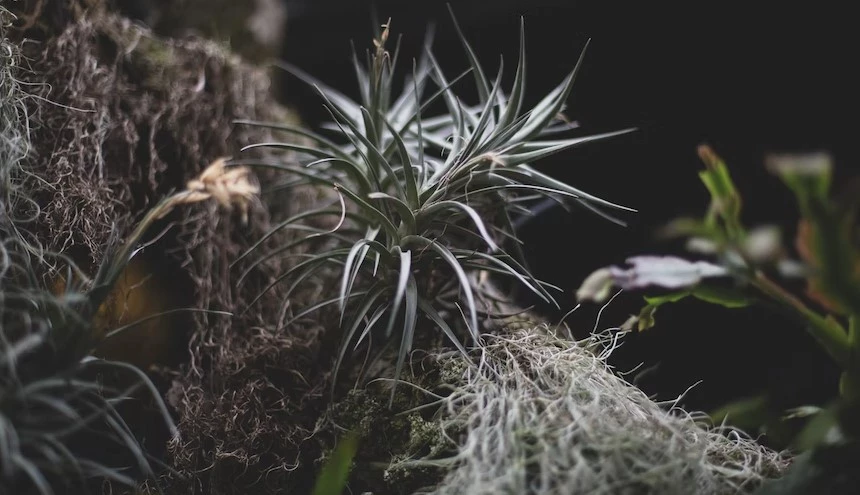
Temperature
Air plants thrive in various temperatures, but extreme temperatures can hurt their health and longevity. They prefer temperatures between 50-90°F (10-32°C). Higher temperatures can cause the air to dry out, whereas low temperatures can lead to freezing and cause plant damage.
During summer, air plants should be kept in a cool, shady area, away from direct sunlight. This will prevent them from overheating.
In the colder months, protecting them from freezing temperatures is essential, which can cause the leaves to turn brown and die. Furthermore, Keeping air plants away from heating and cooling systems is advised, as they will dry the air out, leading to dehydration and plant damage.
Humidity
Air plants thrive in environments with high humidity but can also tolerate low humidity. Keeping the humidity levels at around 50-60% is ideal. Luckily, most homes are within this range, making them a great indoor growing plant.
Light
When considering the type of light air plants prefers, it is important to note that they do not require a specific type of light. They can thrive quite well in various lighting conditions, as long as it is bright and indirect.
Air plants generally tolerate lower light conditions, but they may not grow or bloom as well as they would with brighter light.
If you’re growing indoors, place your air plant near a window where it can receive abundant natural light, but it is essential to avoid direct sunlight. Direct sunlight can cause the temperature to rise too quickly, causing leaf burn and dehydration.
Artificial light is another option to provide your air plants with the light they need to thrive. LED or fluorescent lights are suitable alternatives for providing an air plant’s daily lighting requirements.
If you go down the artificial light path, it’s recommended to keep the light on for 12-14 hours per day to mimic the natural light cycle.
Nutritional factors
While air plants can survive without soil and do not require regular fertilization, they still require essential water and nutrients to stay healthy and thrive. Let’s have a look at how both fertilization and water quality can affect the longevity of an air plant.
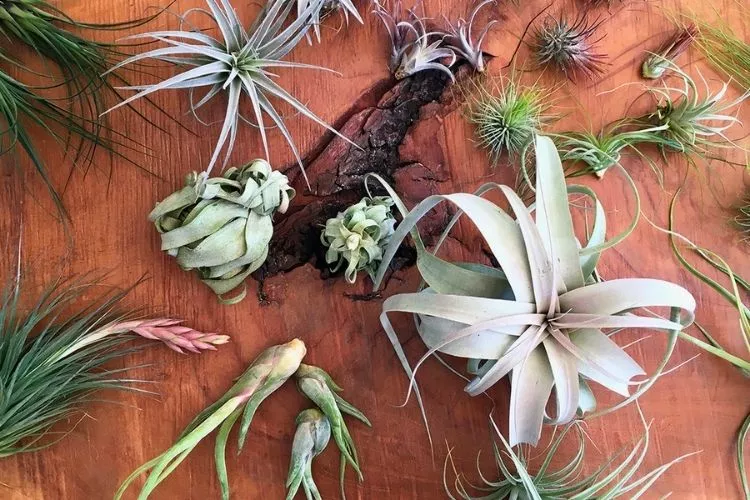
Fertilizers
Air plants absorb nutrients and moisture through their leaves, which means they must be fertilized using foliar feeding. A balanced fertilizer formulated for air plants with a ratio of 10-10-10 or 17-8-22 is recommended.
Air plants should be fertilized monthly during the growing season (spring and summer). During the dormant season (fall and winter), fertilizing can be reduced to once every two months.
Air plants can become weak and susceptible to pests and diseases without proper nutrition, leading to a shorter lifespan. Nutrient deficiency can also lead to stunted growth, and the plant may be unable to produce new leaves and blooms.
Over-fertilizing air plants can also negatively affect their health, leading to root burn and dehydration, which can also lead to plant death. This problem is also amplified when not enough water is administered.
water quality
The quality of the water used to water air plants can significantly impact their health and longevity. Air plants are sensitive to chlorine and other chemicals commonly found in tap water.
The chemicals can damage the leaves and cause brown spots, ultimately leading to plant death. To avoid this, using filtered or distilled water when watering air plants is recommended.
In addition to avoiding tap water, it is also important to avoid using softened water or water that has passed through a water softener. Softened water contains high levels of salt, which can harm air plants and lead to root burn and dehydration.
Air plants should be watered once a week by misting them or soaking them in water for 20-30 minutes, then allowing them to dry completely before placing them back in their display.
Overwatering is another factor that can cause big problems for an air plant’s longevity, so avoid doing so at all costs.
Age of the plant
Simply put, an aging plant becomes less productive and less likely to produce offsets. In this case, attempting to propagate or maintain a degrading plant is more difficult.
Pests and Diseases
Pests and diseases can significantly impact the lifespan of air plants if not addressed promptly. Here are a few examples of common pests and diseases that can affect air plants and how they can impact their lifespan:
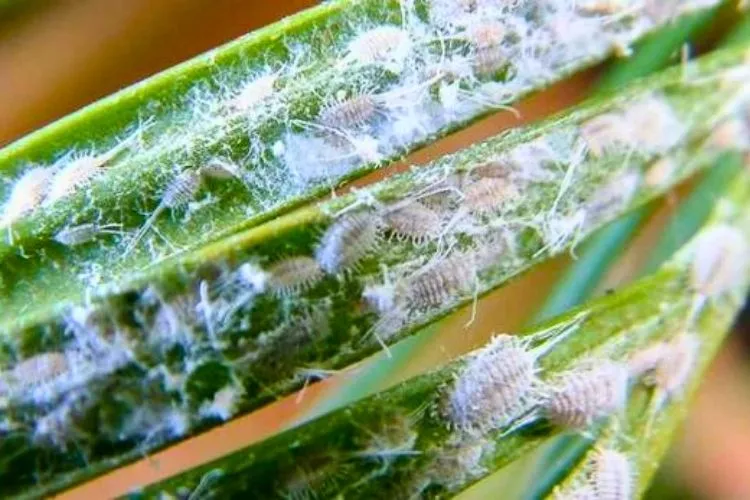
Pests
- Mealybugs: These tiny insects feed on the sap of the air plants, weakening the plant and leaving it vulnerable to other infections. If left untreated, mealybugs can lead to stunted growth and even death.
- Spider Mites: Spider mites are small arachnids that can quickly multiply and cause significant damage to these types of plants. They pierce the leaves and suck all the sap and life out of them. This causes the leaves to turn brown and curl up. Severe infestations can cause plant death.
Diseases
Root Rot: Overwatering or using contaminated water can cause root rot. This disease comes in the form of a fungal infection that attacks the roots of the air plants. As the disease progresses, the roots become mushy and start to rot. This will prevent the plant from absorbing water and nutrients. The longer it is left uncorrected, the faster the plant will march toward death.
To avoid the impact of pests and diseases on the lifespan of air plants, it is essential to inspect the plants regularly and treat any signs of infestation as soon as you see them. We recommend using natural remedies like neem oil or insecticidal soap to control pests or even replanting your air plants when signs of root rot exist.
By ensuring your air plants are healthy and free from pests and diseases, you can help prolong their lifespan and enjoy their beauty for years.
How Long do Air Plants Live?
Air plants have varying lifespans depending on the species and their growing conditions. On average, air plants can live anywhere from several months to several years, with some species living up to 20 years.
The greatest influences on an air plant’s lifespan include varying environmental conditions, nutrition, water quality, damaging pests, and diseases.
By providing them with the right amount of light, water, and nutrients and protecting them from extreme temperatures and pests, you can help ensure your air plants live for many years. Furthermore, administering proper care and maintenance will allow your air plants to live much longer and healthier lives.
Understanding the Life Cycle of Air Plants
Air plants have a unique life cycle that can be broken down into three different stages: the seedling stage, the juvenile stage, and the adult stage. Understanding the life cycle of air plants is crucial for ensuring proper care and maintenance. Let’s have a look at the stages and overall cycle in detail:
The different stages of growth of air plants
These types of plants are quite a joy to grow because of their lack of need for a soil substrate. Therefore, you can watch their roots sprawl and establish themselves.
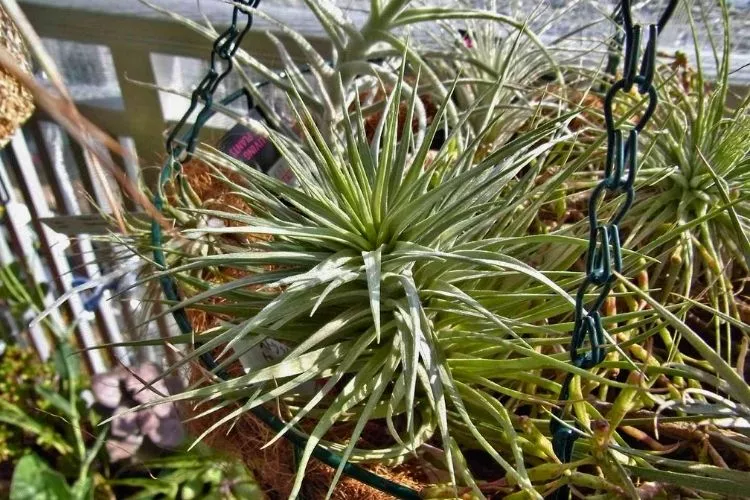
However, don’t get too excited, as they are pretty slow growing. Regardless, anytime you get to see what happens under the soil without having your view blocked is worth the wait. Let’s look at the different stages:
Seedling Stage
The seedling stage is the initial stage of an air plant’s life. During this time, the plant will emerge from a seed. The seedling will begin to develop roots and leaves and require more frequent watering and gentle handling. It should be protected as much as possible from the wind and extreme weather swings or temperatures.
Juvenile Stage
During the juvenile stage, the plant will develop and grow in size. Depending on the growth method, its roots will gain strength and either sprawl or anchor to a substrate. At this point, the air plant will require more light and nutrition to support its growth.
Adult Stage
The adult stage is when the air plant has reached maturity. Both its size and shape should be fully developed. The plant will grow stronger and produce new leaves and flowers during this stage. It will also require less frequent watering.
The lifespan of each stage
The length of time or “lifespan” of each stage varies depending on the air plant species and growing conditions. On average, the seedling stage can last up to six months, the juvenile stage can last up to two years, and the adult stage can last up to several years.
Signs of maturity and decline
As air plants reach maturity, they will start to present signs of this maturity and then decline. Signs of maturity include the development of vibrant colors, the growth of new leaves and flowers, and the production of offsets or “pups.”
Signs of decline may include brown or yellow leaves, a lack of growth, or the appearance of pests or diseases.
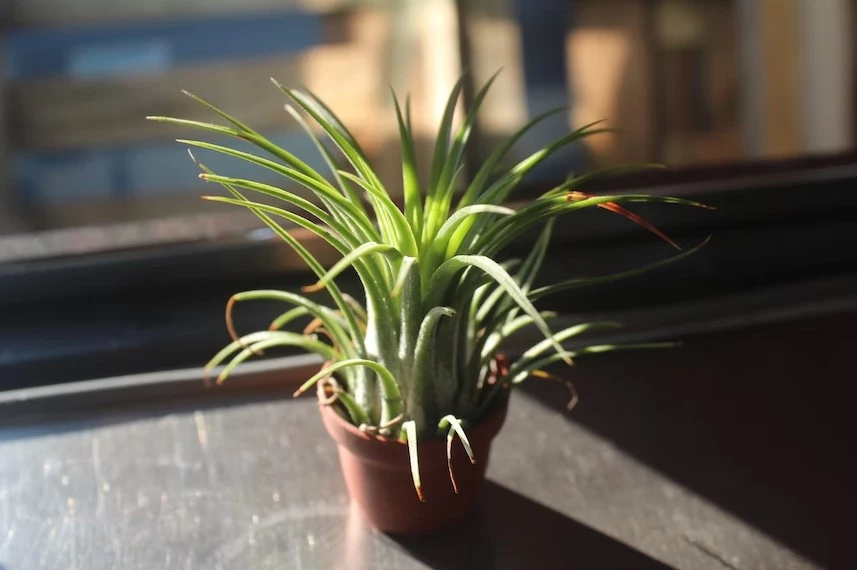
Understanding the life cycle of air plants and the signs of maturity and decline can help you provide the proper care and maintenance when and where necessary to extend their lifespan. With proper care, air plants can continue to thrive and bring beauty to your home or office for many years.
Common Air Plant Species and Their Lifespan
Let’s have a look at some of the more common species of air plants and their life expectancies:
- Tillandsia ionantha: Tillandsia ionantha is a smaller air plant with beautiful, vibrant red/purple flowers that will bloom once in its lifetime. This species typically lives for around 3-5 years and is easy to care for, making it a popular choice for air plant enthusiasts.
- Tillandsia xerographica: Tillandsia xerographica is a larger, slower-growing air plant that can live up to 10 years with proper care. Its unique rosette shape produces beautiful pink or purple flowers on a tall spike.
- Tillandsia caput-medusae: Tillandsia caput-medusae, also known as the medusa’s head air plant, has a distinctive curly appearance that resembles the snakes on the head of the Greek mythological monster. It produces blue or purple flowers on a tall spike and lasts 5-7 years.
- Tillandsia bulbosa: Tillandsia bulbosa is a much smaller, more delicate air plant that produces bright red or pink inflorescence. It typically lasts 3-5 years and is a great option for terrariums or hanging displays.
| Species | Height | Width | Flower Type | Flower Color | Lifespan |
| Tillandsia ionantha | 2-3 inches | 2-3 inches | Spike | Red, Purple | 3-5 years |
| Tillandsia xerographica | 10-18 inches | 8-12 inches | Spike | Pink, Purple | Up to 10 years |
| Tillandsia caput-medusae | 6-12 inches | 6-8 inches | Spike | Blue, Purple | 5-7 years |
| Tillandsia bulbosa | 6-10 inches | 2-3 inches | Inflorescence | Red, Pink | 3-5 years |
How to Prolong the Lifespan of Air Plants?
Proper care and maintenance are key to prolonging the lifespan of air plants. Here are some best practices to ensure their longevity:
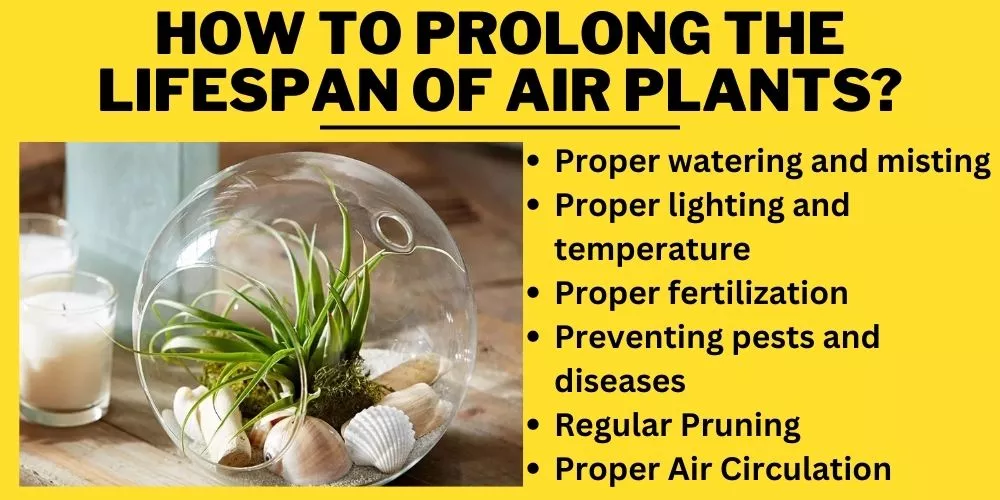
Proper watering and misting
Air plants absorb water and nutrients through their leaves, so misting or soaking them in water regularly is important. Use room-temperature or lukewarm water, as cold water can shock the plants. Avoid using hard water, which can leave mineral deposits on the leaves and harm the plant.
Misting is simple and can be done by adding lukewarm water to a spray bottle and spritzing the plant on its foliage.
Soaking an air plant is done by:
- Placing it in a bowl or basin of room-temperature or lukewarm water.
- Make sure the plant is fully submerged in the water for at least 30 minutes to an hour, depending on the plant’s size.
- After soaking, remove the plant from the water after soaking and gently shake off any excess moisture.
- Then, place it upside down on a towel or paper towel to allow it to dry completely before putting it back in its display location.
It’s important not to leave the plant in standing water or over-soak it, as this can cause it to rot.
Proper lighting and temperature
Air plants need bright, indirect light to thrive. We recommend placing them near a window or under grow lights. Try to mimic the sun as best you can. Avoid direct sunlight, as it can burn the leaves. Try to have them standing or hanging somewhere where they are exposed to warm temperatures that are between 60-80°F (15-27°C)
Proper fertilization
Air plants can benefit from occasional fertilization with a diluted, water-soluble fertilizer. Use a fertilizer specifically formulated for air plants and follow the instructions carefully. Avoid over-fertilization, as this can harm the plant significantly.
Use a balanced fertilizer that is specifically formulated for air plants. Choose one with a ratio of 10-10-10 or 17-8-22. Fertilize your air plants monthly during the growing season (spring and summer). Cut back to once every two months during their dormant season (fall and winter).
Preventing pests and diseases
The most common pests and diseases that can destroy an air plant include mealybugs, spider mites, and fungal infections. Therefore, their growing environments should always be kept clean and well-ventilated. Make it routine to inspect them regularly for signs of pests or disease.
More importantly, treat any issues promptly with the appropriate treatment. Getting on top of these issues fast can be the difference between a short life and a long one.
Regular Pruning
It doesn’t take much for air plants to grow out of control. Therefore, it’s important to prune them regularly to help them maintain their shape and health. Use a sterilized pair of sharp scissors or gardening shears to trim away dead or yellowing leaves or excess growth.
Sometimes, a simple haircut will allow the plant to refocus energy on generating new foliage.
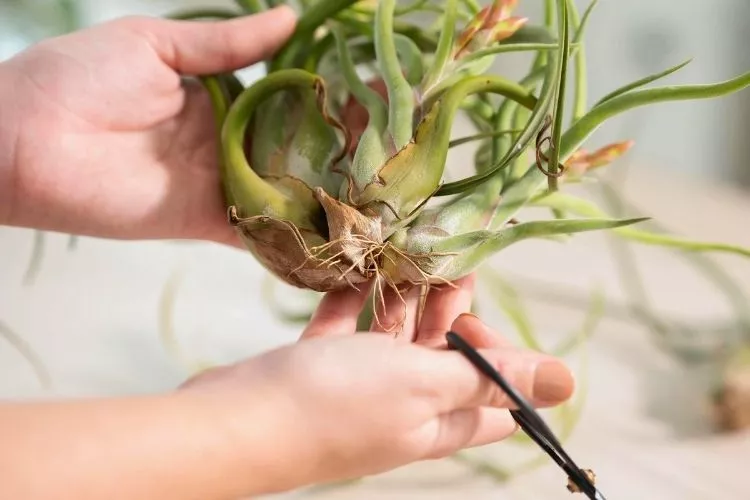
Proper Air Circulation
Air plants need good air circulation to prevent unwanted moisture from building up and contributing to mold growth. Use a fan or open a window to provide adequate airflow. Avoid placing the plants in an area with stagnant air, as this will dry them out and force them into struggle mode as they try to survive.
Frequently Asked Questions (FAQs)
How Do You Know When Air Plants Are Dead?
You can tell if an air plant is dead by examining the base of the plant. Look where the leaves meet the stem. If it is brown and withered, the plant has died. Additionally, if the leaves are falling off, it is a sign that the plant is not healthy.
Do Air Plants Die After They Bloom?
No, air plants do not die after they bloom. After flowering, they will continue to grow and produce new leaves and pups (baby plants).
What is the longest-living air plant?
The Tillandsia stricta is known to be one of the longest-living air plant species, with a lifespan of up to 20 years under the right conditions.
How long can air plants survive without water?
Air plants can survive for a short time without water but need regular moisture to stay healthy. Depending on the species and environmental conditions, they can go upto 1-2 weeks without water.
Can air plants survive in a bathroom?
Yes, air plants can survive in a bathroom if they receive proper care and are not exposed to harsh or direct sunlight. Bathrooms can provide a humid environment that can be beneficial for air plants.
Conclusion:
In conclusion, air plants are fascinating organisms with a unique life cycle and lifespan. To ensure that your air plants live a long and healthy life, it is essential to understand the factors that affect their longevity, including environmental conditions, proper care, and attention to potential pests and diseases.
With proper care, many air plant species can live for several years, providing a beautiful, low-maintenance addition to your home or office.
Remember to soak and mist your air plants, provide appropriate lighting and temperature, and fertilize as needed. We hope this guide has been helpful and informative for air plant enthusiasts.
For more information on similar topics, please visit our website and check back soon for new content.
Include photos of Air Plants and their different stages of growth.


